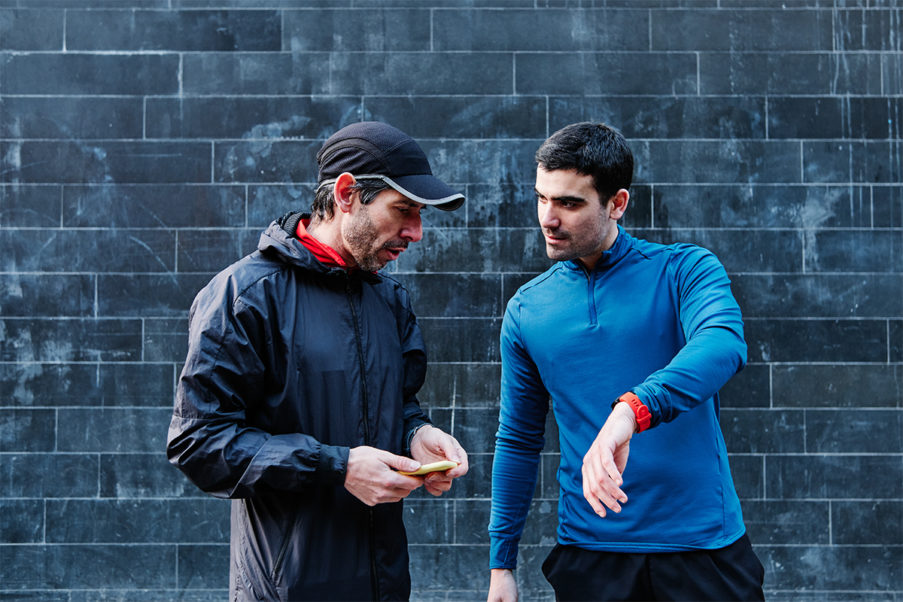What methods do you use to enhance flexibility in clients?

Our personal training studio primarily serves new exercisers or people who have not exercised for a while. Consequently, we require virtually all new clients to schedule an initial fitness assessment prior to exercising with us. During that assessment, flexibility (among other things) is evaluated and problem areas are identified. Commonly, these include the shoulder girdle (especially traps), lumbar region, hamstrings, hip flexors, glutes/hips and calves.
Our general rules of thumb for training flexibility in clients include the following:
- Warm up prior to stretching by completing at least 10–15 minutes of cardio first.
- Include a preworkout stretch only if the client’s lack of flexibility hinders performance.
- Do postworkout stretches that focus primarily on areas that are habitually tight, with an emphasis on the core/lumbar region.
In our small-group classes, we almost always include some stretching as a little “extra love” at the end. Additionally, we sprinkle stretches between exercises during our beginners’ classes in order to lower the intensity and tempo of the class and to do some mind-to-muscle teaching.
The most common methods of training flexibility that we use include manual resistance, Power Plate® (whole-body vibration) and props (dowel, The Stick®, stretching straps and foam roller).
Educating clients about the three main “legs” of fitness (cardio, strength and flexibility) is a tall order—especially when the clients are deconditioned. Taking time to work with people on their flexibility provides a platform to address posture, breathing and the mind-muscle connection, so it certainly is time well spent!
Scott and Barbi Jackson
Owners, Scott Jackson’s Real Life Fitness
Nevada City, California
I dedicate 7–10 minutes to stretching after clients’ circuit workouts. We generally begin the stretch program on the mats. We start with hamstring stretches and then perform the figure-four stretch for the hip and glute areas. I have clients use bands to get more of a stretch and then move the legs to the side for deeper hip and low-back stretches. Then they do pigeon pose and child’s pose. After that, they slowly move up into downward-facing dog and proceed to stretch the upper body. I encourage all clients to do back stretches on the TRX® Suspension Trainer™ before they leave. I suggest they do the figure-four stretch while sitting at work and urge them to incorporate other stretches throughout their week.
Allyson Shumate
AllyFitness
Hermitage, Tennessee
The definition of flexibility has become almost as vague as the meaning of “core” training.hat encompasses flexibility training? We consider flexibility as it relates to improving both functional movement patterns and static positions, such as posture. How we provide flexibility, improve function or improve alignment varies greatly depending on the goals and age of the client and [on when the flexibility work takes place in the session].
At the beginning of our training sessions, most clients complete some sort of dynamic flexibility routine and activation exercises. We sneak in corrective exercise and flexibility work as active-rest stations and conclude most training sessions with a static stretch in the True Stretch Station or on stretching tables, providing assisted stretching or proprioceptive neuromuscular facilitation (PNF stretching).
We develop take-home flexibility programs for many clients and recommend that they complete these exercises 1–2 times per day. Home flexibility programs are a great way of introducing clients to exercising at home and increasing their exercise frequency. Once adherence is there, we begin to add strength or cardio programming. For our athletes and weekend warriors, we design and teach dynamic warm-ups to prepare the muscles for activity.
We are lucky to offer several yoga, stretching and Pilates classes per week, and we offer personal training memberships that allow our training clients to participate in these classes as a membership benefit. Exposure to different exercise modalities promotes adherence and helps clients find other styles of exercise that benefit them differently than working with a trainer.
Dale Huff, CSCS
Co-owner, NutriFormance-Fitness, Therapy and Performance; also, Athletic Republic St. Louis
St. Louis, Missouri
As far as I am concerned, “flexibility in clients” has two meanings. The first is improving and maintaining joint range of motion; the second is teaching clients not to be rigid in their training ideas, methods and schedules. Both are important.
For traditional flexibility, I enhance and maintain joint range of motion in clients in several ways. First, I make sure they understand the importance of stretching after each training session and after each of their own workouts. I explain that not stretching after a workout can have an effect over time on how they move and look by tightening and shortening muscles in some areas and changing how muscles move and hold bones. I explain that this can result in a hunched or arched back, pigeon toes or duck feet, and sometimes a lot of pain.
Second, I emphasize that clients should never stretch cold muscles. I use the example of a box of spaghetti, explaining that when they take a spaghetti noodle out of the box it is rigid because it is uncooked (essentially cold), and when they try to bend it, it will break. When heated in boiling water, it bends easily without breaking. This visual example clarifies the importance of warming up before stretching.
I usually do not have clients stretch before they work out, but after training, they always stretch every muscle group they worked. (The exception would be clients who depend on flexibility to do a sport—gymnastics, for example.) I mostly use static stretches and have clients hold each stretch for 20–90 seconds, doing 1, 2 or 3 reps depending on time—I think static stretching is the safest and most easily understood stretching method for clients to do on their own. Usually I stick to the same basic routine without introducing new flexibility exercises until clients can do the routine on their own in good form.
I do use other methods of stretching, such as PNF stretching, when appropriate, but I caution clients that this type of stretching should be performed by a professional. I never use ballistic stretching, because the injury potential is too great. If a client enjoys yoga or Pilates, I encourage this interest and sometimes include some of those exercises in the routine. I also work on improving posture by including corrective exercises when necessary and asking clients to think consciously about body position during everyday activities. I encourage my clients to stretch really tight areas twice a day after warming up. I have seen improvements in pain and range of motion with people who adhere to this plan.
With all exercises, I ask clients to pay attention and build awareness of body position and of how it feels when a body part is “out of place.” Some clients are so used to being in a poor position that it takes a while for them to learn how correct form feels. I use a balanced program of exercises to “pull joints back into place.” I believe in working all agonist and antagonist muscles in the same workout, whether it is with a resistance exercise for each group or a combination of flexibility for one group and resistance for another. My goal is to give clients as healthy and as pain-free a life as possible.
Part of giving clients a pain-free and healthy life is teaching them my second definition of flexibility in a fitness program. Often people get locked into a certain time for working out or a certain routine, and if they cannot make that happen, they give up. I encourage clients to be flexible with their schedules and routines as well as their bodies, to ensure that they first develop the habit of working out. If they cannot work out at their normal time, they should do it when they can instead of being rigid about, for example, working out only in the morning because they have read that that is the best time of day to exercise.
I also ask my clients to be flexible with exercise by being open to trying new things. The more variety there is in a fitness regimen, the more sustainable it will be over the long term. I make it a point to be up on the latest trends and be creative in my planning so clients will have fun and learn what works best for them from many choices.
Mary Miriani, ACSM Health/Fitness Specialist
Reality Fitness Inc.
Naperville, Illinois
If you have a question, send it to IDEA Fitness Journal via regular mail (see “Your Membership” page); e-mail (content@ideafit.com); or fax (858-535-8234). Include name, company, city, state/province and phone number.




